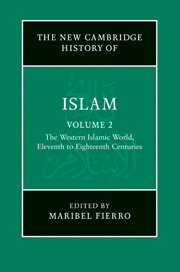Book contents
- Frontmatter
- Introduction
- PART I AL-ANDALUS AND NORTH AND WEST AFRICA (ELEVENTH TO FIFTEENTH CENTURIES)
- PART II EGYPT AND SYRIA (ELEVENTH CENTURY UNTIL THE OTTOMAN CONQUEST)
- PART III MUSLIM ANATOLIA AND THE OTTOMAN EMPIRE
- PART IV NORTH AND WEST AFRICA (SIXTEENTH TO EIGHTEENTH CENTURIES)
- 16 Sharīfian rule in Morocco (tenth–twelfth/sixteenth–eighteenth centuries)
- 17 West Africa (tenth–twelfth/sixteenth–eighteenth centuries)
- 18 Ottoman Maghrib
- PART V RULERS, SOLDIERS, PEASANTS, SCHOLARS AND TRADERS
- Glossary
- Bibliography
- Index
- References
17 - West Africa (tenth–twelfth/sixteenth–eighteenth centuries)
from PART IV - NORTH AND WEST AFRICA (SIXTEENTH TO EIGHTEENTH CENTURIES)
Published online by Cambridge University Press: 28 March 2011
- Frontmatter
- Introduction
- PART I AL-ANDALUS AND NORTH AND WEST AFRICA (ELEVENTH TO FIFTEENTH CENTURIES)
- PART II EGYPT AND SYRIA (ELEVENTH CENTURY UNTIL THE OTTOMAN CONQUEST)
- PART III MUSLIM ANATOLIA AND THE OTTOMAN EMPIRE
- PART IV NORTH AND WEST AFRICA (SIXTEENTH TO EIGHTEENTH CENTURIES)
- 16 Sharīfian rule in Morocco (tenth–twelfth/sixteenth–eighteenth centuries)
- 17 West Africa (tenth–twelfth/sixteenth–eighteenth centuries)
- 18 Ottoman Maghrib
- PART V RULERS, SOLDIERS, PEASANTS, SCHOLARS AND TRADERS
- Glossary
- Bibliography
- Index
- References
Summary
Introduction
Towards the end of the ninth/fifteenth century, West Africa’s externality to the Muslim world began to end. Some of the phenomena of this process are easily detected; others are blurred, taking shape only vaguely. The first appearance of the Portuguese caravels on the Atlantic coast in the 1440s heralded a new era. Its immediate effects, however, remained restricted to the coastal regions where the rival European powers founded military and commercial outposts. From there, the Portuguese had, from the first, made a point of capturing local people and sending them back to Portugal as slaves. They had come to search for the sources of gold – and the priestly King John – and returned with a lucrative alternative: ‘black’ gold. Later in the tenth/sixteenth century came the Dutch, followed by the English and the French, who had all begun to establish colonies in the New World. An infamous traffic began that, during its peak at the end of the twelfth/eighteenth century, amounted to an annual export of an estimated 64,000 slaves from West Africa alone. The intrinsic repercussions that the transatlantic slave trade had on the local societies along the Gold Coast, the Guinea Coast, the Senegambia and the coast of the Moors were felt way into the interior. The trade in firearms unbalanced the political equilibrium; the trade in rum and manufactured textiles undermined morale and economy.
- Type
- Chapter
- Information
- The New Cambridge History of Islam , pp. 480 - 502Publisher: Cambridge University PressPrint publication year: 2010

